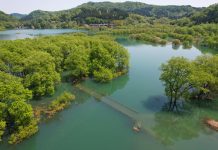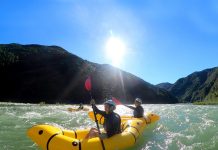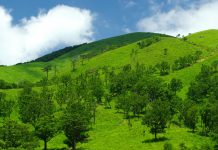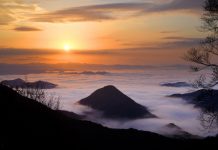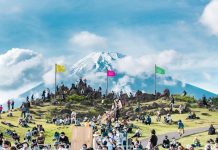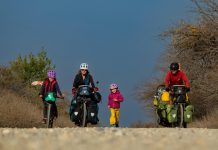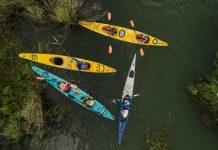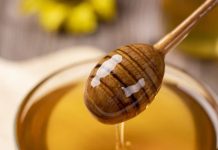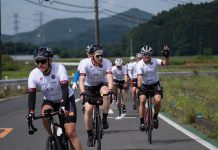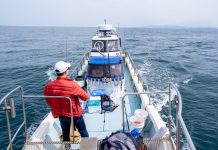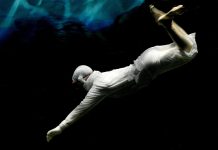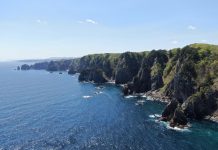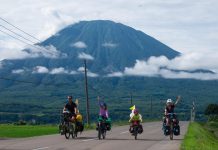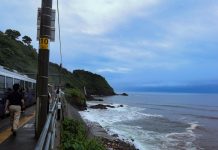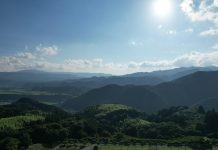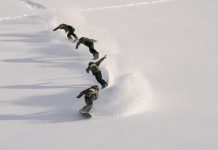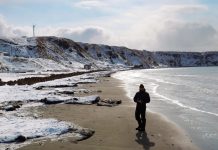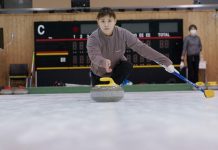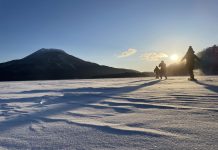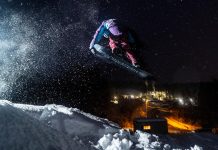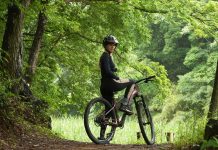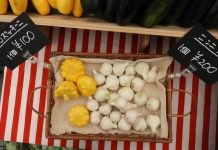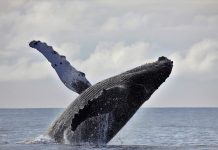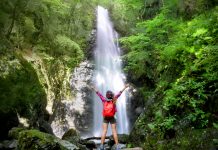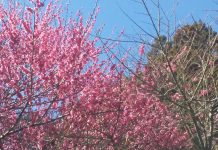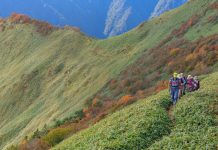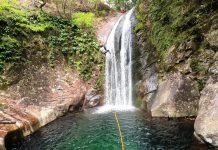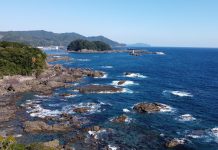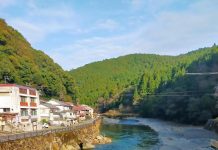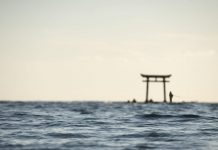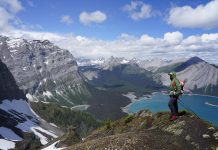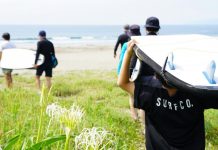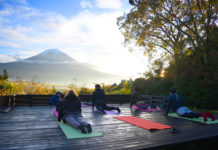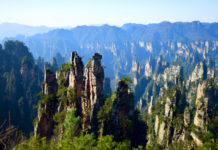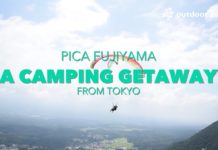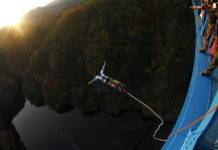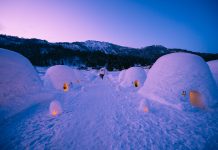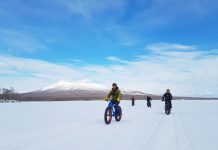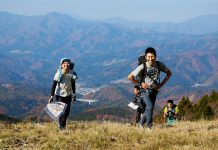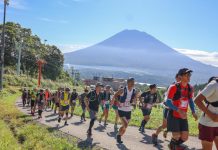For most of its length, the Japan Sea coast is fairly smooth and gentle. It does have magnificent cliffs and rocky sections in many locations, as well as long, uninterrupted stretches of sandy beaches, but it’s a fairly consistent line stretching all the way from Aomori in the north, around the rounded Oga peninsula in Akita, straight down to Ishikawa where the Noto peninsula does jut way out into the sea, then along a long section of flat land and sandy shores.
That changes at Wakasa Bay, roughly the southern half of Fukui Prefecture. It’s as if an enormous sea monster decided to take a big bite out of Honshu Island, with the result a ragged indentation with jutting peninsulas and rugged bays. If you were looking for a place to find an adventure, Wakasa beckons, with its folding, undulating shoreline and steep mountains surrounding the crystalline waters of the bay and often plunging directly into the depths.
While the waters are very inviting, it’s the hills that we want to head into today. We’re going to be climbing up into those mountains that lead into the sea, and we will be in the water, but up in the hills as it tumbles down toward the sea.
The journey begins with a meeting at Kumagawa Juku, a former post town about halfway between Wakasa Bay and Lake Biwa. Traveling on today’s Highway 303, you can just see some traditional buildings and gates off to the side as you rush past. In fact, though, those traditional buildings run on either side of the Saba Kaido—the “Mackerel Road,” the former main road running from the town of Obama on Wakasa Bay close to Lake Biwa, then down to Kyoto. Its name comes from the fact that, for many centuries, this was the transportation route carrying Wakasa Bay’s seafood to the merchants and nobles in Kyoto. Kumagawa Juku—juku a name used for post towns where people traveling on foot could stop for the night—was one important point on the route, and one which today has kept its Edo-era look.

We’re to meet our guide at Sol’s Coffee, a modern café inside one of the old machiya—Edo-style townhouses—lining the street. It’s modern in the coffee varieties, pastries and tools of today’s barista, but pretty much true to the Edo era in the traditional exterior, with an interior that highlights the exposed, centuries-old wooden roof beams and planking.

Hiromichi Murata, owner of guiding company Plus Wild, arrives. He’s a certified mountain guide, but also a keen booster of the current development of Kumagawa Juku.
“There are a lot of young people who are now creating new shops inside these old buildings, like this coffee shop,” he says. “The main thing is that we are trying to keep things local, and to control the development so that we can keep the feeling of the area.” One way they’re doing it here, he says, is by not allowing outside real estate developers to come in. Buildings are sold by individuals to other individuals. So while there are some crumbling buildings now just starting to be rebuilt by new younger owners, several formerly run-down properties have been rebuilt as high-end, tastefully appointed hotels—still with that timeless interior intact—pottery shops, soba restaurants, and more.

Murata-san suggests that, since this is such an historic place, we might want to take in a little of the local culture before heading up into the hills. “Let’s go take a look at the ninja dojo,” he says with a smile.
Full disclosure: your writer has had a pretty negative opinion of ninjas, seeing them as the source of too many tacky tourist destinations, the main characters of B-class TV shows and the source of naming for too many foreign-owned operations in Japan. What we find at the Ninja Dojo Seireikan, though, changes my mind.
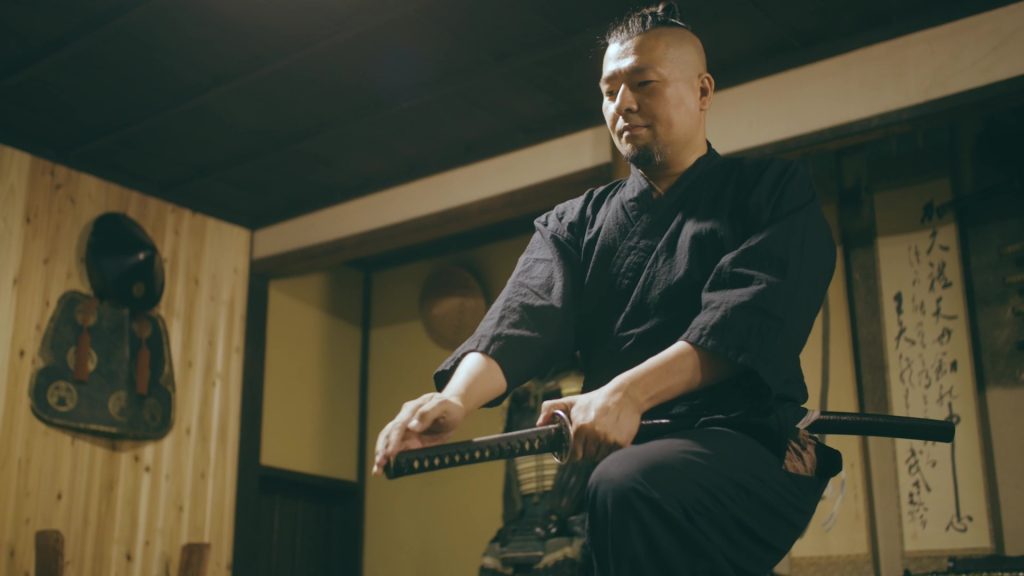
We’re greeted by Yuichi Niino, a woodcarver who also runs the dojo. He’s in appropriately traditional indigo-dyed wear, something like a judo outfit, topped off with a slightly modernized chonmage topknot. But he immediately dispels any worries that we’re going to be fed old clichés.
“Real ninja didn’t wear black!” he exclaims. “It’s not like what they show on TV and in the movies. They didn’t really use throwing stars, but more often used rocks, or other things they could find all around them.” He explained that their role was most often as hired guns, people with special skills who would be summoned from their homes in this area by the ruling Koga family in what is today neighboring Shiga prefecture.
So with some local history and a revised view of ninja under our belts, Murata-san says it’s time to start heading for today’s destination—heading down from Kumagawa Juku to the flatlands below, slightly to the north and then up from the base of Mt. Kumotani for a day of sawanobori—canyoneering along the Imako River up into the heart of the mountain.

The area lies just to the southwest of Mikata Lake, the southernmost of the five lakes of Wakasa. The van heads up and up an increasingly rough and rugged road bouncing up into the deep valleys of this mountainous area.
“I think it’s a very Japanese style of river experience,” Murata-san says. “There’s a series of waterfalls that we can climb up as we go up the Imako River. The climb is a lot of fun—and coming back on ropes down the waterfalls is really exciting!”

Canyoneering usually conjures up images of wet-suited and helmeted adventurers clambering up along a swiftly flowing river (meaning it also can seem as though it’s a bit too, ah, “refreshing”). While all guests are in wetsuit, harnesses, helmets and non-slip boots, Murata-san stresses that the day’s trip is going to be a fun one. “The water is pretty warm throughout the climbing season, so we can stay in the water for long periods of time without having to worry too much about exposure,” he explains. “The water contains a lot of iron, so it’s also slightly yellow in color. It’s fun throughout the season, but I really recommend doing sawanobori in autumn, when the colors are really beautiful.”

The adventure is as promised. After getting into wetsuits, helmets and harnesses, Murata-san and a few of his friendly guides check us out, give some quick instructions on how they will handle the ropes and how we will approach the flowing water, pools and waterfalls, and then begin the initial climb from the road up to the first of a series of waterfalls.
It’s simply a lot of fun, clambering up the wet rocks of the waterway with the steady hand of a guide on the rope in case of slipping. It’s almost even a little warm in the wetsuits (which, luckily, come in sizes big enough for even us 190-cm-plus people), but Murata-san gives us plenty of chances to take a slide into one of the natural pools below the falls and cool down in the water. It also is a very personalized experience: we met no other cars on the road, or other groups on the river. The terrain is a beautiful setting of deep forests and the winding river; we occasionally get glimpses of the nearby ocean through the trees, and almost wished we were on one of the longer courses that would take us higher up the mountain. After sliding and splashing back down the series of waterfalls along the river, too soon we’re back at the vans, ready to get out of the neoprene and back into normal clothes.

“I usually suggest a four to five-hour course for first-time guests,” Murata-san says as we start down the rocky road. “The actual course we chose depends on the guest’s ability, experience and interest. We can even arrange for a course that families can enjoy safely. Or, if the guests are really genki, we can climb all the way to the summit of Mt. Kumotani. From there, they will have spectacular views of the other mountains in the area, the lakes and all along the coastline.” That’s the one I kind of hoped for, knowing what beautiful scenery lies all around Wakasa Bay—but that’s for the next, private trip.
Safety is of course a main concern in sawanobori, so Murata-san takes no more than three guests with him, adding more guides as needed as the groups get larger (but, he says, they’re not interested in guiding large groups). After the challenge of scrambling up the warm, rocky river, the descent sees the guides lowering guests down the splashing waterfalls on ropes.
Along with providing the expert guides for the day, Plus Wild provides all the required equipment. The fee is ¥25,000 per person for two people, ¥20,000 each for three and gear rental fee is ¥3,000 (contact Murata-san for more information for larger groups). He adds that he doesn’t just guide during the warm months, but also leads snowshoeing tours in the hills in winter as well.
It’s a great experience in this beautiful setting, just one of the many things to do that make the historic, scenic and often very natural Wakasa area of Fukui such a special place on the Japan Sea coast.

Helpful Information
Book your sawanobori adventure with Plus Wild
Contact: Hiromichi Murata
Email
Learn more about Kumagawa-juku here.
Getting There
The Wakasa area of Fukui is nicely off the beaten path, so getting there makes for a bit of a journey—but it’s nice country along the way.
From Tokyo, take the Tokaido-Sanyo shinkansen to Kyoto Station; transfer there to the Thunderbird Express (if your timing/planning is good) to Omi-Imazu Station; otherwise, transfer at Kyoto Station for the local train on the Tokaido-Sanyo Line (which becomes the Kosei Line) to Omi-Imazu. From there, transfer to the Wakae Line bus for Tachibana-machi, the stop for Kumagawa Juku. Total time for the trip will be about three hours and 45 minutes if you catch the Thunderbird, or four hours 15 minutes by the local train. Murata-san will pick up sawanobori guests at Omi-Imazu Station, as will some area hotels.
From Osaka, the fastest route is by Special Rapid Tsuruga train on the Tokaido-Sanyo/Kosei lines direct to Omi-Imazu, then by bus or your guide’s van to Kumagawa Juku. This will take about two hours; other trains will take about two and a half hours.

